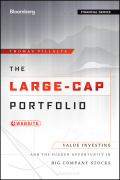
The large-cap portfolio: value investing and the hidden opportunity in big company stocks + web site
Villalta, Thomas
The practical guide to finding value and opportunity in large-cap stocks using investor behaviorLarge-Cap is an abbreviation of the term "large market capitalization" and refers to the stock of publicly traded companies with market capitalization values of roughly more than $10 billion, like Walmart, Microsoft, and Ford. Because of their size, the conventional view is that these companies do not present investors with an ability to be opportunistic. The Large-CapPortfolio + Website argues that, contrary to popular perceptions, significantopportunities exist in these stocks.Written with a fluency that both the savvy amateur and professional investor will understand, the book fills a void in the market by offering the practitioner a methodology to identify and approachthe major assumptions that underlie valuation, with an emphasis on issues that are more relevant to the analysis of large-cap stocks.Full of useful information on how to reap the rewards of stocks that most investors avoidPresents essential insights into understanding stock valuationIncludes an actionable chapter devoted to portfolio managementPacked with timely instruction, Large-Cap Portfolio gives readers invaluable insights and examples of how to build portfolios that will out-perform broad market benchmarks. INDICE: Acknowledgments xiPreface xiiiPART I: THE LARGE-CAP OPPORTUNITY AND CHALLENGECHAPTER 1 Trends in Large-Cap Investing and the Opportunities They Present 3Defi ning a Large-Cap Stock 4Understanding the S&P 500 Index 8Examining the Growth of Indexed Equities 10Defi ning Active Management 13So What Does This Mean for Investors? 25Two Additional Considerations 28Finally, Something Timely 29Conclusions 31Notes 31CHAPTER 2 Risk and Uncertainty 35FinancialMeasures of Risk 37Accounting Measures of Risk 41Differentiating between Certain and Uncertain Cash Flows 43Conclusions 48Notes 49PART II: MARKET INEFFICIENCYCHAPTER 3 An Introduction to Market Efficiency 53The Basis for Market Effi ciency 55Effi cient Markets Hypothesis 58Empirical Support for the Efficiency of Markets 59Conclusions 60Notes 61CHAPTER 4 Evidence of Ineffi ciency in Investor Behavior and Market Behavior 63Closed-End Fund Discounts and Premiums 64Market Bubbles and Market Crashes 68Investors vs. Their Investment . . . or Investors vs. Themselves 73Book-to-Market Effects and Other Value Criteria 76Conclusions 78Notes 79CHAPTER 5 Individual Decision Making 81That Thing about Our Being Rational . . . 84Bayesian, Non-Bayesian—What Does This Mean? 87Great Companies Always Make Great Stocks 90Representative Sequences 93Now That You Put It That Way . . . 96Dropping an Anchor in a Sea of Information 105Conclusions 110Appendix: Utility Theory and Prospect Theory 112Notes 116CHAPTER 6 Correlated Mistakes and the Failure of Arbitrage 119Herding and Why We’re Predisposed to Correlated Mistakes 120Evidence of Herding in Securities Markets and in the Analysis of Common Stocks 123Feedback Mechanisms and Mood Contagions 126Smart Arbitrageurs Will Save Us! Won’t They? 129Some Related Considerations in Approaching the Active Management of Investments 133Conclusions 135Notes 136CHAPTER 7 Conventional Views on Sources of Market Inefficiencies 139Structural Impediments to Market Effi ciency 143Pertinence to Large-Cap Universe 150Conclusions 154Appendix: Underexplained Market Phenomena 155Notes 158PART III: RESEARCH AND PORTFOLIO MANAGEMENTCHAPTER 8 Identifying Large-Cap Stock Opportunities and Optimizing Research Processes 163Identifying Large-Cap Stock Opportunities 164Filters and Relative Assessments of Value 165Subjective Identifi cation of Overoptimism and Overpessimism 173Overconfi dence, Information Overload, and the Structure of Investment Firms 177Conclusions 180Notes 181CHAPTER 9 Approaching Growth in Large-Cap Stock Research 183Are We Good at Predicting Growth? 185Equity Valuation Basics 187Limitations to Estimating Long-Term Growth Rates 190Abnormal Growth Magnitude and Abnormal Growth Duration 190Traditional Methods for Determining Growth 196Perversions of Growth Estimates in Large-Cap Stocks 199Recognizing that Markets Are Effi cient over theLong Term: A Refresher on Microeconomic Theory 214Some Further Considerations When Predicting Growth Rates 227Solutions 228Conclusions 231Notes 233CHAPTER 10 Hewlett-Packard Company Case Study 235A Look at HPQ’s Historical Performance and Operations 236Behavioral Biases and Evidence of Analyst Overreaction 241Evaluating the Market’s Assessment of HPQ’s Growth Prospects 243Pulling It All Together251Appendix: Calculating Underlying AssumptionsRelevant to the Valuation of HPQ 253Notes 258CHAPTER 11 The Challenges of Managing Large-Cap Common Stock Portfolios 259Understand Your Universe and Benchmark 260Off-Benchmark Securities264Position Sizes 269Turnover 271Commodity-Oriented Holdings in the Large-CapPortfolio 272Macroeconomics and Portfolio Management 276Conclusions 279Notes 280What’s on the Companion Website 281About the Author 282Index 283
- ISBN: 978-1-118-25660-2
- Editorial: John Wiley & Sons
- Encuadernacion: Cartoné
- Páginas: 304
- Fecha Publicación: 13/06/2012
- Nº Volúmenes: 1
- Idioma: Inglés
